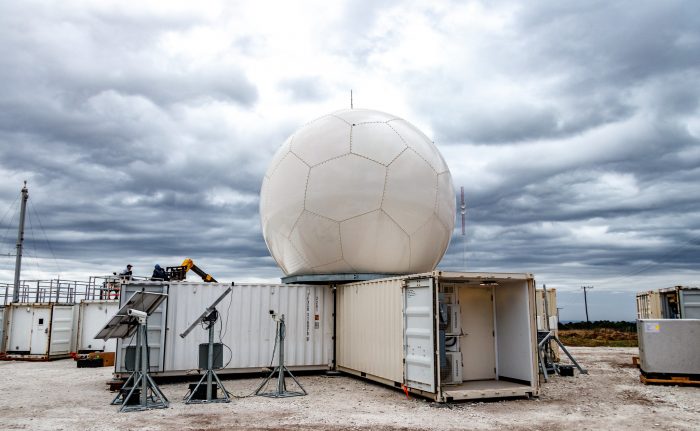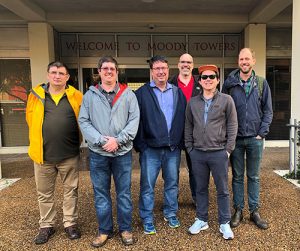Intensive cloud study in Houston led by BNL’s Mike Jensen may improve weather forecasts

By Daniel Dunaief
Before they could look to the skies to figure out how aerosols affected rainclouds and storms around Houston, they had to be sure of the safety of the environment on the ground.
Researchers from several institutions, including Brookhaven National Laboratory, originally planned to begin collecting data that could one day improve weather and even climate models on April 15th of this year.
The pandemic, however, altered that plan twice, with the new start date for the one-year, intensive cloud, study called TRACER, for Tracking Aerosol Convection Interactions, beginning on Oct. 1st.
The delay meant that the “intensive observational period was moved from summer 2021 to summer 2022,” Michael Jensen, the Principal Investigator on Tracer and a meteorologist at Brookhaven National Laboratory, explained in an email.

At the same time, the extension enabled a broader scientific scope, adding more measurements for the description of aerosol lifecycle and aerosol regional variability. It also allowed the researchers to include air quality data, funded by the National Aeronautics and Space Administration and urban meteorology, funded by the National Science Foundation.
The primary motivation for the project is to “understand how aerosols impact storms,” Jensen explained in a presentation designed to introduce the TRACER project to the public.
Some scientists believe aerosols, which are tiny particles that can occur naturally from trees, dust and other sources or from man-made activities like the burning of fossil fuels, can make storms stronger and larger, causing more rain.
“There’s a lot of debate in the literature” about the link between aerosols and storms, Jensen said.
Indeed, there may be a “sweet spot” in which a certain number or concentration of aerosols causes an invigoration of rainstorms, while a super abundance beyond that number reverses the trend, Jensen added.
“We don’t know the answers to those questions,” the BNL scientist said. “That’s why we need to go out there and take detailed measurements of what’s going on inside clouds, how precipitation particles are freezing or melting.”
Even though aerosols are invisible to the naked eye, they could have significant impacts on how mass and energy are distributed in clouds, as well as on broader atmospheric processes that affect weather patterns.
The TRACER study, which is a part of the Department of Energy’s Atmospheric Radiation Measurement, or ARM, user facility, could “help forecast heavy rains that can cause flash flooding,’ said Chongai Kuang, atmospheric scientist and TRACER co-investigator at BNL.
The TRACER study will explore the way sea and bay breeze circulations affect the evolution of deep convective storms as well as examining the influence of urban environments on clouds and precipitation.
Several additional funding agencies have stepped in to address basic scientific questions, including the National Aeronautics and Space Administration’s efforts to address air quality issues in Houston and the Texas Commission on Environmental Quality, which funded a study on ozone and low-level atmospheric mixing.
“Our original TRACER field campaign provided a seed for what is now a major, multi-agency field campaign with a significantly expanded scientific scope,” Jensen explained in an email.
A joint team from BNL and Stony Brook University is developing new software to scan the precipitation radar system to select and track storm clouds to observe the rapid development of these storms. Additionally, aerosol instrumentation will help provide updated information on the precursor gases and the smallest aerosol particles at the earliest stages of the aerosol cycle, Jensen explained.
Ultimately, the data that these scientists gather could improve the ability to forecast storms in a range of areas, including on Long Island.
“Understanding sea breezes and the coastal environment is a very important aspect of TRACER,” Jensen said. “Even though it’s not the preliminary focus, there’s an opportunity to learn new science, to improve weather forecasting and storm forecasting for those coastal environments.”
Researchers chose Houston because of their desire to study a more densely populated urban area and to understand the way numerous factors influence developing clouds, weather patterns and, ultimately, the climate.
“We know the urban environment is where most people live,” Jensen said. “This is taking us in new directions, with new opportunities to influence the science” in these cities.
Researchers plan to collect information about clouds, aerosols and storms everywhere from ground-based instruments stationed at four fixed sites, as well as through mobile facilities, to satellite images.
The program operates a tethered balloon which is “like a big blimp that goes up half a mile into the atmosphere,” said Heath Powers, the Atmospheric Radiation Measurement facility site manager for Tracer from Los Alamos National Laboratory.
The tethered balloon is located at Smith Point, Texas, on the eastern shore of Galveston Bay and will do low-level profiling of aerosols, winds, thermodynamics and ozone as it is influenced by bay breeze circulation, Jensen explained.
The National Science Foundation is planning to bring a C-130 plane to conduct overflights, while the group will also likely use drones, Powers added.
The TRACER study will launch around 1,500 weather balloons to gather information at different altitudes. The research will use over four dozen instruments to analyze meteorology, the amount of energy in the atmosphere and the air chemistry.
“Clouds are the big question,” Powers said. “Where they form, why they form … do they rain or not rain. We are well-positioned to get at the core of a lot of this” through the information these scientists gather.






